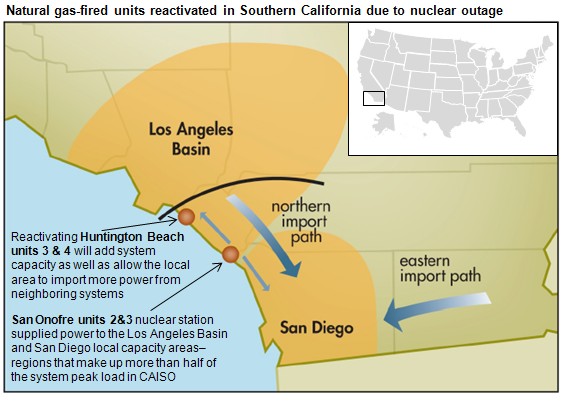
California's electric power market faces challenges heading into summer

California's electric market will face a number of challenges this summer, the greatest of which is making up the loss of two nuclear units (San Onofre 2 & 3) in an area of significant congestion on the electric system. The California Independent System Operator (CAISO)—the electric system operator for most of the state—will also contend with the normal challenges of managing this complex system including: dry to moderate drought conditions in much of the state, an increasing amount of variable generation from renewable sources, and the challenge of importing about 23% of its peak system load from sources outside CAISO.
The North American Electric Reliability Corporation's recent Summer Reliability Assessment cited the San Onofre (SONGS) unit outages as the main contributor to a reserve margin of 15.1%—just 0.1 percentage point above the target level for this region.
California enters the summer without 2,150 megawatts (MW) of net summer generating capacity due to the extended outage of SONGS units 2 and 3 north of San Diego. As a result, the Southern California area will be short of electric generating capacity. One key step was the return to service of 450 MW of capacity from two retired natural-gas fired units at the AES Huntington Beach power plant.
The loss of SONGS poses multiple reliability issues beyond the loss of baseload capacity. When SONGS is unavailable, the transmission grid may be more vulnerable to potential disruption if another contingency (e.g., loss of another major generating unit or an important transmission line) occurs.
In addition, because of the configuration of the California transmission grid, the loss of SONGS can potentially reduce imports of power into the key Los Angeles and San Diego load centers. This is crucial because California cannot meet peak demand relying only on in-state generating plants. Reduced import capacity may put the California grid further at risk. This is particularly an issue for San Diego, which is a "load pocket" with limited local generation, relying on imports from the East.
As shown in the map, Huntington Beach has a similar location in the grid as SONGS. In addition to making up part of the capacity shortfall, bringing Huntington Beach units 3 and 4 back on-line restores some ability to import power into southern California. Restarting these two units will restore 350 MW of lost import capacity (see the CAISO Summer Operations Briefing for more detail).
Along with this action, CAISO is also taking these initiatives:
- Use existing demand response programs fully as well as seek additional military and public agencies to participate in demand response
- Fully fund the Flex Alerts, a public outreach energy conservation program
- Accelerate work on transmission upgrades along the southern path from the San Onofre power plant
- Accelerate work on the "Sunrise Powerlink" transmission project to link San Diego to other parts of the system
Beyond the relatively rare instance of a nuclear power plant in extended outage this summer, California must also contend with several issues more typical to this market.
As well as importing significant hydroelectric power from the Pacific Northwest, California has a significant supply of in-state hydroelectric capacity. Snowpack, which Western hydroelectric resources depend upon for water supply, has been much below normal in the Sierras, and the U.S. Drought Monitor from the Department of Agriculture, as of May 29, showed abnormally dry to moderate drought conditions in much of the state. The likely effect of this will be a reduction in the amount of hydroelectric generation the system operator can call on.
Integrating increasing amounts of wind, solar, and other intermittent sources of electricity may complicate ramping and voltage support on the CAISO system. According to the latest CAISO Market Monitoring report, nearly 3,000 MW of wind and solar sources are expected to be added in 2012, nearly 70% of all planned generator additions for the year.